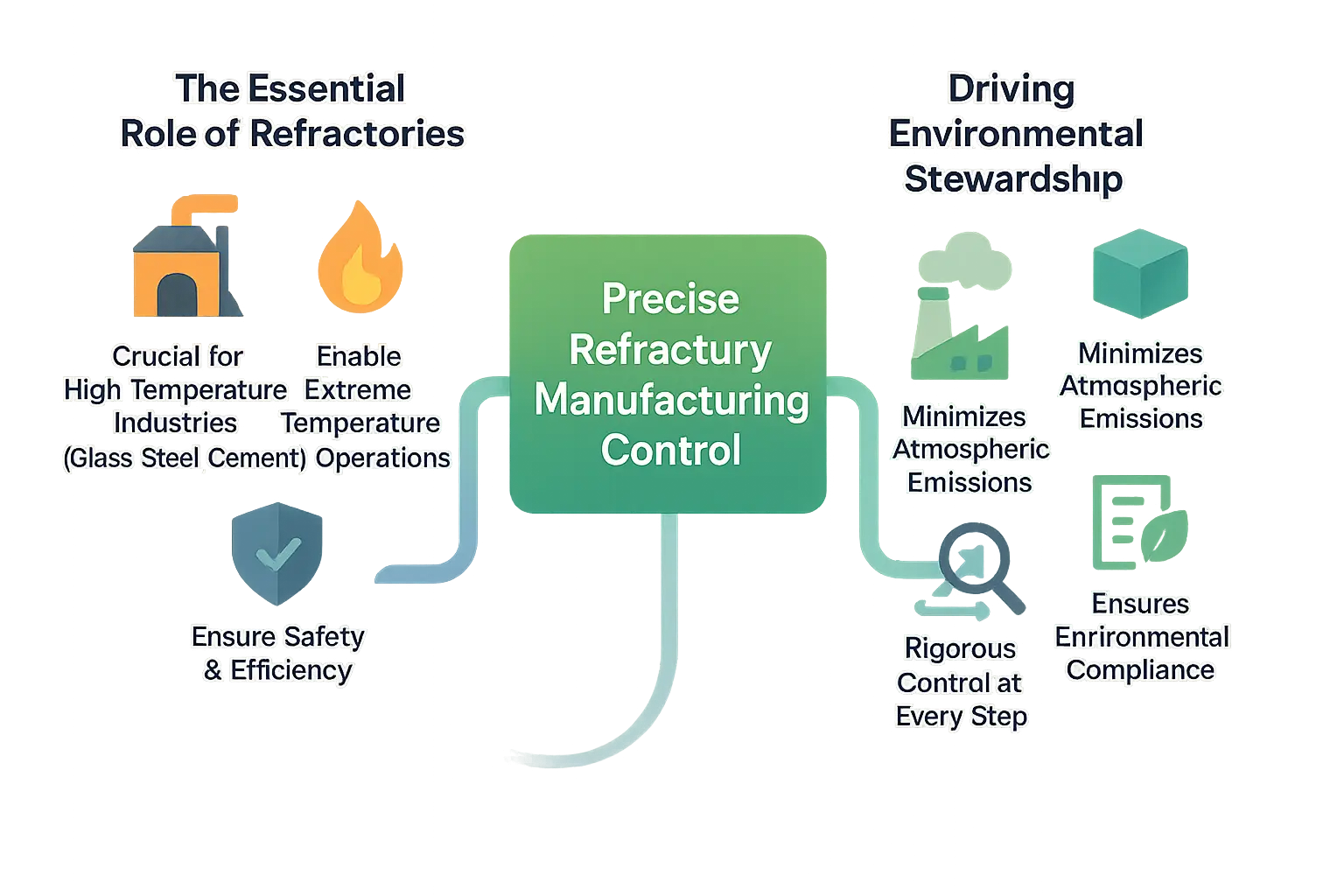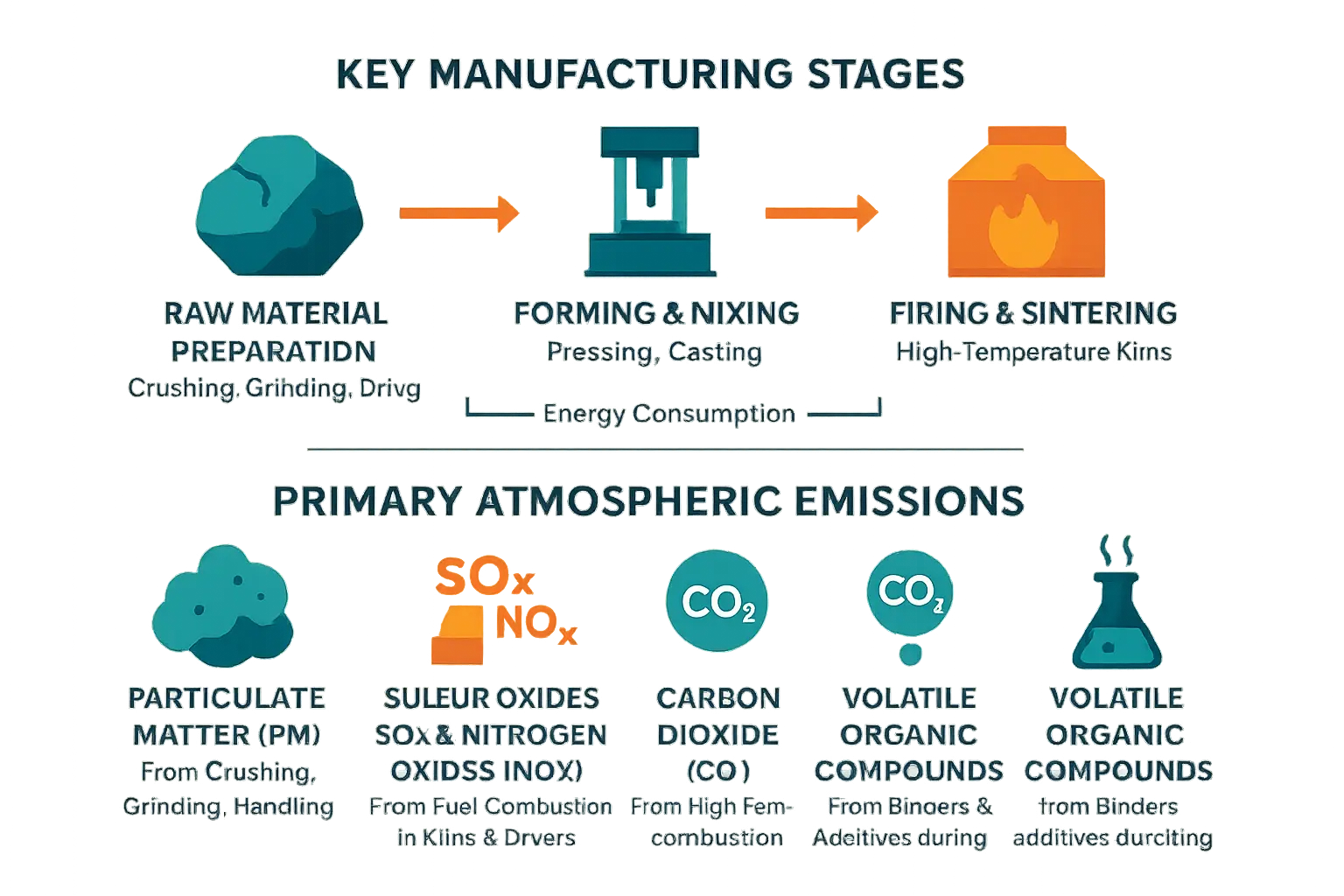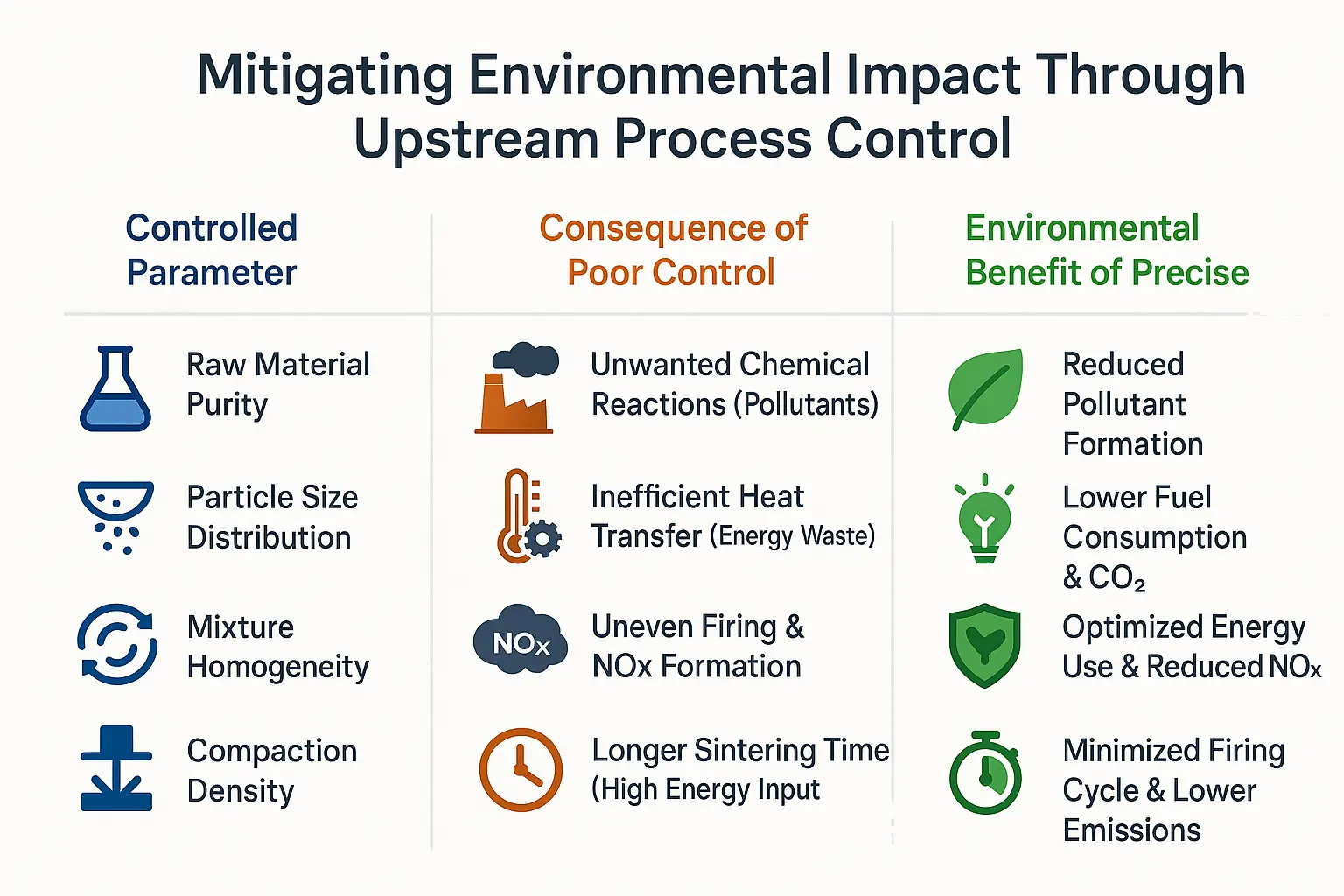Are manufacturers of refractory products overlooking hidden environmental costs in their pursuit of performance? Refractory manufacturing control isn’t just about durability—it’s a critical lever for reducing atmospheric emissions like NOx, SOx, and CO2 while achieving strict environmental compliance. By optimizing parameters—from chemical composition and granulometry of raw materials to optimized firing curves and bulk density—industries can slash energy consumption, minimize waste, and ensure processus de fabrication durable. This article dives into how precise control at every stage, from material selection to quality assurance, transforms high-temperature industries into sustainable operations, extending product lifecycles and reducing regulatory risks—discover the science behind cleaner, smarter refractory production.
- Why precise refractory manufacturing control is key to environmental stewardship
- Understanding the refractory manufacturing process and its environmental footprint
- How controlling raw material and mixing parameters mitigates environmental impact
- Firing and sintering: the critical stage for emission control
- Quality assurance as a pillar of environmental compliance
- Strategic refractory management for a sustainable future
Why precise refractory manufacturing control is key to environmental stewardship

The essential role of refractories in high-temperature industries
Refractory products form the backbone of industries like steel, glass, and cement, where furnaces operate at temperatures exceeding 1,500°C. These materials must withstand extreme thermal stress, chemical corrosion, and mechanical wear. Without refractory products, high-temperature industries would face catastrophic equipment failures and safety risks. For example, in steelmaking, refractories line converters and ladles, ensuring molten metal containment. In glass manufacturing, they prevent furnace degradation from molten silica at 1,600°C. To understand their technical role, learn what refractory materials are.
Beyond performance: The environmental impact of manufacturing
Precise refractory manufacturing control isn’t just about durability—it’s a regulatory imperative. Strict parameters during production directly reduce atmospheric emissions like formaldehyde and polycyclic organic matter (POM) from resin binders. For instance, optimizing sintering temperatures minimizes volatile organic compound (VOC) release during curing. Compliance with standards like the U.S. National Emissions Standards for Hazardous Air Pollutants (NESHAP) requires advanced control technologies (MACT), slashing emissions of hydrochloric acid and hydrogen fluoride by 80-95% in modern facilities.
Environmental compliance extends to lifecycle assessments (LCA). Studies show energy consumption accounts for 40-60% of a refractory’s carbon footprint. By refining parameters like bulk density and porosity, manufacturers reduce material waste and energy use. For example, a 10% improvement in thermal conductivity can cut furnace energy demand by 5%, directly lowering CO₂ emissions. This precision ensures environmental compliance while maintaining operational efficiency. Advanced refractories with controlled creep resistance also minimize dimensional changes at high temperatures, preventing cracks that could release particulate matter into the atmosphere during industrial operations.
Understanding the refractory manufacturing process and its environmental footprint

An overview of key manufacturing stages
The refractory manufacturing process involves three critical stages: raw material preparation, forming/mixing, and firing/sintering. Each phase demands precise control to minimize environmental impact.
Raw material preparation begins with crushing, grinding, and drying of materials like alumina or magnesia. This stage consumes significant energy and risks particulate matter (PM) emissions if dust is not captured. Proper selection and preparation of raw materials ensures purity and reduces waste.
Forming/mixing includes pressing or casting materials into molds. Uncontrolled pressure or binder ratios can lead to defects, increasing waste and reprocessing needs. Advanced forming techniques optimize material use, directly lowering emissions.
Firing/sintering occurs at temperatures up to 1,800°C, where energy efficiency is critical. Inefficient combustion here escalates NOx, SOx, and CO2 emissions. Precise temperature control ensures complete combustion, reducing pollutants.
Identifying the primary sources of atmospheric emissions
Uncontrolled manufacturing stages release pollutants threatening air quality and human health. Key sources include:
- Particulate matter (PM): Generated during crushing, grinding, and drying of raw materials, as well as finishing processes.
- Sulfur oxides (SOx) and Nitrogen oxides (NOx): Emitted from fuel combustion in kilns and dryers, driven by sulfur content in raw materials.
- Volatile Organic Compounds (VOCs): Released when binders decompose during heating, often linked to tar and pitch used in carbon-bonded refractories.
- Carbon dioxide (CO2): The primary byproduct of fossil fuel combustion in high-temperature processes.
Additional hazards include heavy metals (e.g., chromium in magnesite-chrome refractories) and fluorides released during sintering. Without advanced controls like fabric filters or wet scrubbers, these emissions exceed regulatory thresholds, risking penalties and ecological damage.
For example, uncontrolled rotary dryers emit 15 kg/ton of PM, while chrome-based refractories release hexavalent chromium—a potent carcinogen. Modern systems like multi-stage scrubbers reduce PM by 99%, demonstrating how parameter control mitigates risks.
How controlling raw material and mixing parameters mitigates environmental impact
The role of chemical purity and granulometry
Did you know impurities in raw materials cause 30% more pollutant formation during refractory firing? For every 1% increase in impurities, NOx formation rises by 2.5% through secondary reactions at high temperatures. This directly impacts compliance with environmental regulations like the EU’s Industrial Emissions Directive.
Modern producers use XRF analysis to maintain purity above 98%. For instance, magnesia bricks with 98.5% purity reduce CO2 emissions by 12% compared to standard 95% purity bricks during calcination. This precision helps meet strict limits on particulate matter under the UNECE Gothenburg Protocol.
Granulometry control uses laser diffraction to maintain D50 values between 5-15 µm, reducing energy consumption by 15-20% during sintering. This precision lowers CO2 output by optimizing packing density and decreasing kiln residence time. For example, optimizing particle size distribution in alumina-silica mixtures cuts PM10 emissions by 18% through improved thermal transfer efficiency.
Moisture control prevents energy waste from excess evaporation. Advanced plants use microwave sensors to maintain 0.3-0.5% moisture content, reducing natural gas consumption by 8-12% in tunnel kilns. This aligns with ISO 14067 carbon footprint standards by minimizing Scope 1 emissions.
The importance of mixture homogeneity and compaction
Non-homogeneous mixes create hotspots that boost NOx formation by up to 40%. Consistent mixing prevents damaging temperature variations while improving thermal distribution. This aligns with the International Energy Agency’s energy efficiency benchmarks for industrial furnaces.
| Controlled Parameter | Consequence of Poor Control | Environmental Benefit of Precise Control |
|---|---|---|
| Raw Material Purity | Unwanted chemical reactions producing CO and NOx | 30% reduction in pollutant formation |
| Particle Size Distribution | Inefficient heat transfer requiring 15-20% more energy | 12% lower fuel consumption and corresponding CO2 emissions |
| Mixture Homogeneity | Uneven firing causing 40% more NOx | Optimized energy use with 25% reduction in NOx emissions |
| Compaction Density | Extended sintering time increasing energy demand by 20-25% | Minimized firing cycle reducing CO2 emissions by 18% |
| Moisture Content | Excess water requiring additional evaporation energy | 10% lower gas consumption through optimized moisture levels |
Compaction pressure control reduces sintering time by 3-4% per 5% improvement in green body density. Modern isostatic presses achieve 1.5% density variation tolerance, ensuring uniform particle bonding. This precision helps meet Scope 3 emission targets for raw material production, where 90% of product carbon footprint originates.

Firing and sintering: the critical stage for emission control
Optimizing temperature profiles and firing duration
Refractory manufacturing hinges on precise temperature control during firing. A 10°C/min heating rate with ±5°C furnace accuracy ensures proper mullite formation in alumina-silica compositions. Overfiring by 50°C increases fuel consumption by 15%, elevating CO2, SOx, and NOx emissions. Kaolin-based refractories calcined at 1350°C achieved optimal cold crushing strength (CCS) while reducing energy waste by 60% compared to less precise methods. Studies using the Grey Taguchi method found that a 70% chamotte, 28.5% raw kaolin, and 6.5% potter’s clay mix reached superior thermal shock resistance (TSR) at this temperature, demonstrating how precise thermal profiles optimize both material properties and environmental outcomes.
The 3-hour hold time at peak temperature enables complete phase transformations without excess energy input. Extending this duration by 20% increases NOx formation by 8% due to prolonged high-temperature exposure. Insufficient firing creates unstable microstructures, accelerating degradation and increasing maintenance-related emissions. Modern programmable furnaces reduce energy fluctuations by 12% through adaptive temperature curves, balancing product quality with ASTM standards for refractoriness under load (RUL) and apparent porosity. This precision ensures long-term operational efficiency while minimizing atmospheric impact.
The significance of furnace atmosphere control
Atmosphere composition during firing directly impacts pollutant formation. Maintaining oxygen levels within 2-5% reduces NOx generation by 30% compared to excess-air conditions. Advanced staged combustion systems lower NOx emissions to <100 ppm, meeting EPA standards while preserving reducing atmospheres for carbon-containing refractories. High-emissivity ceramic coatings like Cetek further enhance efficiency by improving heat transfer by 60%, reducing fuel use by 5.0 Gcal/h and lowering bridge wall temperatures by 21°C. For Al2O3–SiC–C composites, controlled atmospheres prevent carbon oxidation above 600°C. Silicon powder additives form SiC whiskers, improving thermal shock resistance by 40% while maintaining low porosity.
Cutting-edge methods like cyanuric acid injection optimize NOx reduction through two-stage decomposition (538-1649°C) followed by oxygen-rich reaction zones, achieving <100 ppm emissions. These advancements enable compliance with environmental regulations, reducing CO2 emissions by 9,600 metric tons annually in large-scale operations. By integrating precise atmospheric engineering, manufacturers address both technical performance and emission control requirements in modern refractory production while extending equipment lifespan through corrosion-resistant microstructures.
Quality assurance as a pillar of environmental compliance
How quality tests validate an eco-efficient process
Quality control tests for refractory materials serve as critical indicators of both product performance and environmental efficiency. Parameters like bulk density and porosity reflect how well raw materials and manufacturing steps have been optimized. For instance, a high bulk density suggests proper compaction and minimal voids, which correlates with reduced energy consumption during firing processes. Similarly, cold crushing strength (CCS) measurements ensure mechanical integrity, indirectly signaling that sintering temperatures and durations were precisely maintained—key factors in minimizing CO₂ emissions.
When refractory products meet specifications like pyrometric cone equivalent (PCE) and refractoriness under load (RUL), it confirms that thermal treatments achieved their intended chemical and physical transformations. This precision prevents energy waste and excessive fuel use during production. By guaranteeing these properties, manufacturers demonstrate that their refractory manufacturing control aligns with eco-efficient practices, directly supporting compliance with regulations like the EPA’s NESHAP standards.
Meeting regulatory standards through proactive control
Environmental regulations such as the EPA’s NESHAP standards mandate strict controls on hazardous air pollutants (HAPs) like formaldehyde and hydrogen fluoride. Proactive refractory manufacturing control—adjusting parameters like firing temperature and raw material composition—prevents pollutant formation rather than relying on end-of-pipe solutions. This approach not only meets regulatory compliance but also reduces reliance on costly filtration systems.
- Proactive emission reduction: Controlling parameters at the source prevents pollutant formation.
- Enhanced energy efficiency: Optimized processes cut fuel use, lowering CO₂ and other emissions.
- Consistent compliance: Robust process control maintains emissions below regulatory limits.
- Reduced operational costs: Lower energy use and fewer end-of-pipe treatments save money.
By integrating quality assurance into environmental strategies, manufacturers ensure that high-performance refractories align with sustainability goals. This synergy between quality and compliance positions precision manufacturing as a cornerstone of modern industrial responsibility.
Strategic refractory management for a sustainable future
Industrial progress and environmental responsibility converge through precise refractory manufacturing. Controlling production parameters reduces emissions while maintaining performance, transforming sustainability in steel, glass, and cement industries. This approach addresses regulatory requirements while enhancing operational efficiency through data-driven manufacturing.
The lifecycle impact of controlled manufacturing
Precise parameter control creates durable materials with extended lifecycles. Longer-lasting products reduce raw material consumption, manufacturing energy use, and waste generation. For instance, optimizing porosity and creep resistance ensures materials withstand thermal shocks and chemical corrosion, minimizing premature failures. Advanced techniques optimize thermal performance, minimizing heat loss and lowering carbon footprints without compromising production standards.
Comprehensive lifecycle analysis reveals sustainability opportunities. Examining the entire lifecycle of refractory materials shows how controlled manufacturing reduces environmental impact across all stages. By improving dimensional stability and corrosion resistance, companies decrease replacement frequency, cutting resource extraction and transportation emissions. This holistic approach aligns with global circular economy goals.
Partnering with an expert for sustainable performance
Choosing the right refractory partner means selecting an organization that turns manufacturing precision into environmental compliance. MXS Refractories combines performance with responsibility through:
- Advanced sensors for real-time data collection on temperature and wear patterns
- AI and machine learning for predictive adjustments in production parameters
- Data analytics to improve energy efficiency and reduce emissions by 15-20% in industrial applications
These innovations meet regulations while setting new sustainability benchmarks. Continuous production data analysis enables MXS to refine processes, minimize waste, and maximize efficiency. Their solutions merge traditional manufacturing excellence with modern technology, delivering materials that perform under extreme conditions while maintaining strict environmental standards for long-term industrial sustainability. By integrating predictive maintenance tools, MXS helps clients reduce unplanned downtime by up to 75%, further lowering operational carbon footprints across glass, steel, and cement sectors.
Precise refractory manufacturing control minimizes emissions (NOx, CO2, VOCs) and energy use in high-temperature industries. By optimizing raw material purity and firing efficiency, manufacturers ensure compliance and durability. MXS Refractories leverages advanced technologies to deliver eco-efficient solutions, aligning industrial performance with sustainability goals through rigorous process control and innovation.
